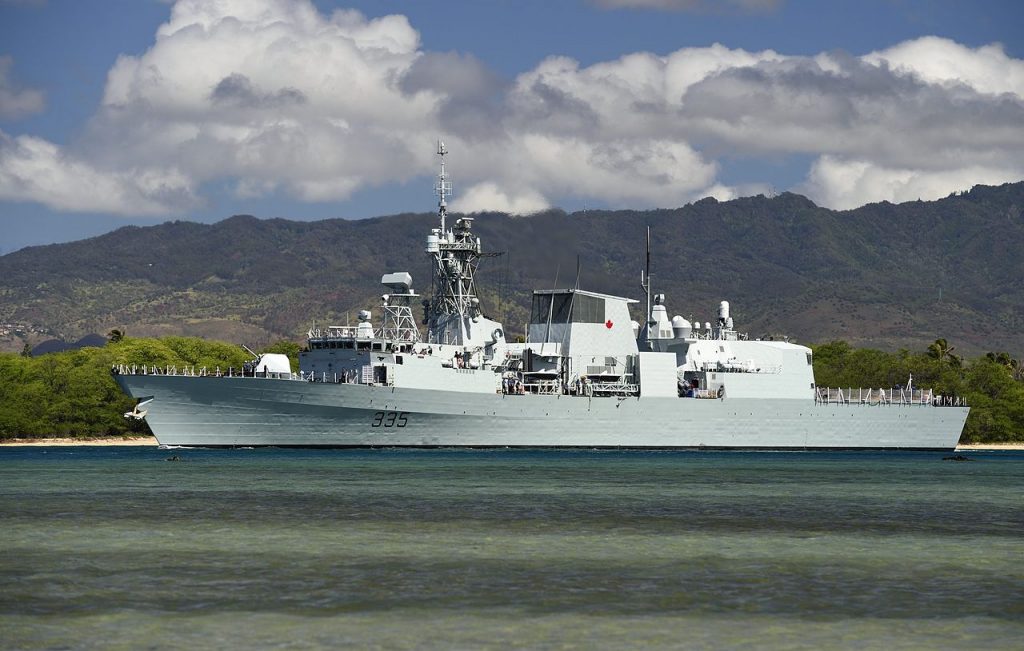
Canada’s Halifax Class frigates are very capable in both anti-air and anti-submarine warfare. Canada built 12 of them between 1987-1998 and they are the backbone of the Canadian navy. They have recently been fully upgraded with new weapons and electronics and will serve Canada till the early 2040’s.
Halifax Class frigates are 134 meters in length, have a displacement of 4,700 tons, a top speed of 30 knots and a range of 17,500 km. (at cruising speed of 15 knots).
Canada recently updated most of the systems on these frigates and plans to keep doing so till the 15 new Canadian Surface Combatant ships are built. The following upgrades have been completed:
- new Combat Management System (CMS 330)
- 57mm Mk3 naval gun system
- MASS decoy launchers
- new Integrated Platform Management System
- CH-148 Cyclone helicopter capability
- Advanced Harpoon Weapon Control System
- new ESM
- Smart-S Mk2 radar
- CEROS 200 fire control radar
Canada is also in the process of adding multiple (likely 4 on each frigate) Mini-Typhoon .50cal remote fire stations that are for close-in fire support. The Mini-Typhoon system is for use against being swarmed by small speed boats or drones. It is a stabilized gun platform that is computerized for accurate targeting and is non deck penetrating for easy installation.
Canada has a poor record in military procurement and I am sure this will continue well beyond my lifetime. Canada has big plans for building 15 Type 26 frigates (Canadian Surface Combatant) to replace the 12 aging Halifax frigates.
Canada has been customizing the Type 26 design and has increased its lethality and increased its weight by about 1,000 tons. Contract negotiations have proceeded rather well, with Canada making some bold moves to make its new war ships more than just capable but down right top notch. However, looking at the contracts they seem to be for only 3 ships. Now I realize that these ships will be built in batches, which is the usual practice in these types of procurements. But, knowing Canada and how politics plays into every purchase and with this very extended time line this will be doubly true. After all, we are talking about a 2050 completion date. I seriously doubt that Canada is going to build more than 6 of the Type 26 frigate. They are just to costly, after all, we are talking about over 3 billion dollars base cost per ship. Construction starts in 2023 with delivery of the first ship by 2031 which will not actually be in service till closer to 2035.
So doing some simple math, Canada will only have built at most 6 new frigates, while retiring its entire fleet of 12 Halifax frigates and 12 Kingston coastal patrol ships.
Canada needs to get real now and start planning on filling out its navy with a smaller and less costly option. The future of navies is in light attack crafts and we need to start planning accordingly. We need to replace the 12 Kingston class coastal patrol ships so we might as well look at beefing up our own coastal defense with 8 to 12 blue water capable corvettes in the 90 meter length that could take over some of the roles of a frigate. These corvettes would cost less than half a billion dollars each, and we could pump them out fast.
Canada could buy the five 10 year old K130 corvettes that Germany will be selling shortly to some NATO country. We need to make doable plans–NOW. Because 15 Type 26 frigates is not going to happen. Even with 15 Type 26 frigates we need new coastal patrol ships. They can save us money by not having to use our very costly frigates. Another reality is our shortage of sailors. A frigate needs a crew of 3 to 5 times that of a corvette/coastal patrol ship.
image sources
- 1280px-HMCS_Calgary_(FFH-335)_leaves_Pearl_Harbor_in_July_2014: CAF Sgt. M. McGregor | US Navy photo